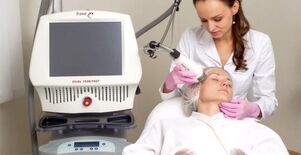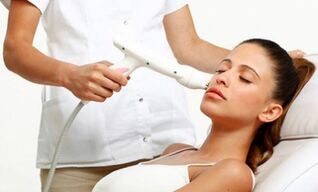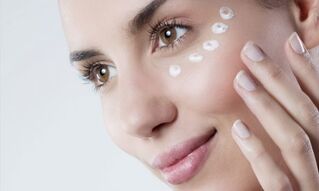Aging is a natural biological process that affects all tissues of the human body, including those that make up a person's appearance. At the same time, facial tissue is more susceptible to aging than others, as it is always under the influence of environmental factors, chewing, mimicking and speech functions. Since the face is a kind of "visitor card" of a person, the problem of caring for and restoring the youth of facial skin is very important and relevant. Among the many methods and techniques used today to solve this problem, laser facial rejuvenation requires special attention.
The essence of this method lies in the effect of laser beam breakdown on the skin. The laser flow is divided into many thin rays affecting the microscopic area of the skin, located at a strictly determined depth, and evaporating it. The intact cells located between these areas stimulate the active production of collagen and elastin - two major "building materials", which are less and less formed in the human body with age. After this procedure, skin tone improves, fine and moderate wrinkles are improved, bags under the eyes are removed and facial contours are tightened. At the same time, the recovery period is minimized. Fractional laser rejuvenation can be used not only as an independent method, but also to improve the results of plastic or laser surface surgery.

Laser used for fractional laser rejuvenation
For the first time in the world, a patent for the principle of fractional laser exposure was obtained in 2004 by the American company Palomar Medical Technologies. Fractional laser systems are now represented by various laser technology companies. The most widespread are laser systems from Palomar and Fraxel, Affirm lasers from the well-known American company Cynosure, GentleYAG lasers from Candela and others. Since all of these attitudes have the same principle of action, the outcome of the procedure is highly determined by the professionalism of the expert conducting the procedure.
Contraindications to laser rejuvenation procedures
The absolute contraindications to the procedure are:
- Pregnancy, breastfeeding.
- Focus on the inflammatory process in the affected area.
- Psoriasis and dermatosis.
- Herpes infections focus on the affected area.
- The chemical skin from the intended treatment area was performed less than two weeks before the procedure.
- Oncological diseases.
- Systemic diseases of the blood, immune system, connective tissue.
- Diabetes mellitus at the decompensation stage.
- Severe forms of hypertension and coronary heart disease.
- Varicose veins in the procedure area.
- Tendency to form keloid scars.
- Family history of vitiligo.
Relative contraindications include active sunlight exposure in the last three weeks before the procedure, i. e. the presence of fresh sunburn, as well as superficial and middle skin done in the treatment area less than three weeks before the procedure.
Fractional Laser Rejuvenation Benefits
Thanks to the dot effect, skin damage is minimal, as all traces after the procedure disappear in 3-4 days.
This method allows you to treat large areas of skin in one procedure, while maintaining and activating the source of skin regeneration, which provides rapid recovery and long-term growth of positive effects.
This procedure does not require anesthesia, it can be performed on the neck, décolleté and eye area.
Side effects are rare. Possible complications include the temporary appearance of reddish-purple spots in the treatment area, mild and rapid itching, activation of herpes infections, changes in skin texture, including burns, flaking, and crusts. Scars, hypertension and skin hypopigmentation in the procedure area are very rare, but can be permanent.
What is the complete laser rejuvenation procedure
A fractional laser exposure session lasts 20-40 minutes, depending on the nature of the problem and the area of the treated area. Repeated procedures are performed in 3-4 weeks. As a rule, 3-4 sessions are required in total. The maximum positive effect occurs within three months after the last procedure. It is recommended to conduct maintenance sessions once every 10-14 months.

What to do after laser facial rejuvenation procedure
A slight burning sensation that may be felt after the procedure disappears in 1-2 hours, while redness and mild swelling can last for 1-3 days. During this period, external agents (creams, ointments, sprays) containing dexpanthenol should be used, for example, Bepanten, Panthenol, D-Panthenol. After the disappearance of the listed symptoms and before the next procedure, a cream with hyaluronic acid is applied.
You can take a shower and wash on the day of the procedure, but it is better to wait with the sauna and swimming pool. Foundation can be used a day after the procedure.
It is mandatory to use sunscreen with a protective factor of at least 30, because at this time the skin's metabolism is activated, and becomes very sensitive to sunlight.
After the procedure, it is necessary to adhere to the recommendations of the specialist performing the procedure. The choice of cosmetic product, its frequency and duration of use is determined individually and depends on the skin type and its characteristics.
Fractional laser rejuvenation is a cosmetological procedure in which the skin is exposed to a laser arrangement of microbes. The purpose of this effect is to activate the process of regeneration and collagenogenesis. This is a relatively new hardware technique, but it is already very popular. In other words, it is called fraxel, laser fractional resurfacing or photothermolysis.
Principles of operation and type of fractional laser rejuvenation
How do fractional lasers work? The micro-rays emitted by the device cause heat shock, in response to which the "lazy" skin cells begin to function more actively. To repair the damaged area, they divide faster. Old cells that do not function dead, give way to the young. Warming of the inner layers of the skin is accompanied by partial denaturation of proteins, as well as the formation of new components of the extracellular matrix, including elastin and collagen.
With depth of effect, ablative and non-ablative laser rejuvenation are distinguished. The first is shallow and resembles grinding. Laser treatment of the upper layers of the skin is accompanied by evaporation of moisture, damage to the epidermis. After healing, the skin becomes firmer, relief and color is evenly distributed. During phototrolysis is not ablative, the laser affects the deep layers of the skin. In this case, no open wounds are formed.
Each type of rejuvenation has its advantages and disadvantages. Therefore, the reabsorption effect of ablative laser can be seen after the first procedure. With this method, you can get rid of deep wrinkles and age spots, acne, stretch marks, scars. With non-ablative procedures, there is no risk of infection and the rejuvenating effects can be seen for several years. This type of phototrolysis is recommended for people under the age of 40 with the first signs of aging: fine wrinkles, reduced turgor.
Instructions and contraindications to the procedure
Photothermolysis procedures should be performed if any:
- Skin sagging, sagging.
- Fine and deep wrinkles, crow's feet.
- Pigmentation from any origin.
- Increased sebum secretion.
- Enlarged pores, prone to acne.
- Scars, stretch marks, after acne.
- Vascular "star" (couperosis).
- Dull skin.
Contraindications to fractional laser rejuvenation are:
- Allergies, psoriasis.
- Autoimmune diseases.
- Pregnancy, breastfeeding.
- Blood diseases.
- Skin infections, inflammation in the affected treatment area.
- All chronic diseases in the degree of decompensation.
- Oncology.
- Increased body temperature.
- Diabetes mellitus.
- Tendency to form keloid scars.
- Epilepsy.
Laser rejuvenation features
Preparation for a fractional phototrolysis procedure consists of deducting a two-week visit to the solarium and beach. During this time it is also impossible to clean the skin, perform chemical exfoliation, take sulfonamide, fluoroquinolones, tetracyclines. Three days before the procedure, they stopped going to the pool, bathroom, sauna, treating the area exposed to alcohol-containing cosmetics. To avoid complications, cosmetologists can prescribe antiviral and antibacterial medications for this period. The day before the procedure should be spent without alcohol and cigarettes, do not go to the gym.
Before laser treatment, the skin is cleansed of cosmetics and impurities. Generally, the laser effect feels like an unpleasant tingling sensation, but sometimes pain is needed. In this case, the make-up artist uses anesthesia on the finished skin area. After the ointment works, she continues to treat the skin with a laser. The duration of the procedure depends on the area of the treatment area and ranges from a few minutes to an hour. Finally, the skin is cooled with a nourishing cream.
In the first few days after the procedure, you should not use alcohol-based products, compressing the body parts where phototrolysis is done with compression linen. It is recommended to exclude physical activity for a week, visit the swimming pool, sauna or bath, limit the time spent on the road. The skin is moisturized with a special cream three times a day. And for half a month. It is undesirable to exfoliate, using cosmetics with retinol, salicylic acid. For two months, it is necessary to use a cream with a sun protection factor of 35 or more.
How many procedures do you need to achieve the result? What effect can you expect?
The recovery period after laser fracture rejuvenation lasts from 3 to 7 days. The speed of recovery depends a lot on lifestyle. Alcohol consumption, smoking, excessive activity, unbalanced diet, insomnia and anxiety can slow down the regrowth process.
During the first three days after laser exposure, redness of the skin and slight swelling may occur. Anesthetics and skin cooling can help reduce discomfort. It is normal if the skin feels tight within a week, there are unstable areas. The side effect of this procedure is the bronze color, which disappears on its own after half a month.
Continuous results after fractional phototrolysis occur after 2-5 procedures. More specifically, the number of sessions can only be determined by a beautician, based on preliminary data. The interval between procedures is 3-4 weeks. As a result of fractional laser rejuvenation, the aging process is inhibited: wrinkles disappear or become less noticeable, turgor increases, pore severity decreases, and skin improves. This method is an effective tool in combating scars, pigmentation, post-acne, stretch marks.
Fractional laser rejuvenation is one of the three most popular hardware cosmetic procedures. Its advantages include efficiency, short healing period, physiological. The results can be seen after the first procedure and last up to three years. This method has various indications. It is possible to choose the depth of laser exposure.
A woman of all ages wants to see beautiful skin in a mirror, but not everyone is willing to go under a plastic surgeon's knife.
In this case, fractional rejuvenation will save by using a laser, which in modern cosmetology takes one of the first places in the anti-aging procedure.
Types and methods of exposure
Ablative photothermolysis
There are two methods of phototrolysis, each suitable for different cases. The right choice to choose the best option will help the cosmetologist make the first appointment.
This method is suitable for rejuvenating skin that is just beginning to experience natural aging.
The laser-assisted micro-damage network only affects the top layer of the epidermis, forcing it to regenerate in a short time.
The results appear after the first procedure, immediately after the wound has healed.
Non-ablative photothermolysis
This method is a slightly more serious intervention. The laser beam penetrates the deep layers of the epidermis, ignoring the outer cells.
Damage also drives the production of elastin and collagen, as in ablative phototrolysis.
The healing process takes longer and the effects are more pronounced. Ideal for getting rid of serious facial problems.
Reading
Anyone who wants to rejuvenate without a serious brace can use this method.
Fractional laser treatment against many imperfections on the face, including:
- very noticeable wrinkles on the forehead;
- nasolabial folds;
- crow's feet around the eyes;
- epidermis "flows down";
- skin pigmentation, scars, scars, spider veins;
- enlarged pores, acne.
Laser therapy has proven to be very effective in getting rid of all these problems.
The only caveat is that depending on the severity of the imperfections, some procedures may be required.
Contraindications
Like other external influences on the body, fractional laser rejuvenation has its own contraindications, where it is prohibited to use such procedures.
This includes:
- the presence of severe inflammation on the face;
- Infectious, fungal skin lesions;
- epidermal diseases - psoriasis, eczema;
- excessive dryness of the skin;
- malignant neoplasms in the body;
- history of epilepsy;
- heart disease;
- varicose veins on the face;
- herpes in the acute stage;
- pregnancy, breastfeeding;
- immune deficiency conditions;
- bronchial asthma, serious allergic reactions;
- neurological diseases.
All contraindications are conditional, that is, the beautician weighs all the risks of the patient.
Sometimes you have to first undergo treatment for skin problems or wait for the remission of chronic diseases, after which rejuvenation is still done.
Setup
Since this intervention is not a surgical operation, no serious preparation is required. Initially, you should consult a cosmetologist who will assess the condition of the skin, and will also give recommendations on the necessary rejuvenation methods.
Patients must tell their doctor about all the conditions and diseases in history, as well as the worsening of chronic diseases for the last six months.
If any, the specialist will advise you to see a specialist to assess the safety of the procedure.
You should also undergo blood and urine tests to identify or exclude inflammatory processes in the body. The first visit date is then set.
Implementation
Fractional laser skin rejuvenation in the facial area is done outpatiently, that is, the patient enters, treatment is done, then he returns.

Previously, beauticians used creams or anesthetics based on lidocaine on the epidermis.
Actually, the procedure is not very painful, so sometimes therapy is done without going through this stage.
Please note that the use of local anesthetics slightly inhibits the natural growth of the skin afterwards.
Then the patient lies on the couch, and the specialist adjusts the depth of the laser beam penetration using a special tool. This device targets specific areas of the epidermis, deep into which the laser penetrates.
Manipulation lasts from half an hour and more, depending on the area to be treated with the device. During the procedure, the patient may feel a slight tingling sensation, as well as an unpleasant odor.
Immediately after the session, a number of red spots appear on the face, the skin is red, slightly swollen, so it is better to take care of the way home first.
Possible complications
Fractional rejuvenation does not include complications. In some cases, they are normal and disappear within a few days.
Others develop due to inexperienced beautician or lack of proper facial care during the recovery period.
What is not the norm:
- severe pain or swelling in areas exposed to laser beam;
- wounds do not heal in two weeks;
- pigmentation and scars appear.
Mild redness, flaking and itching are predictable conditions for any type of epidermis.
Such consequences will disappear on their own in 1-2 weeks, leaving no visual impairment.
Recovery
The outcome of the procedure is strongly influenced by the patient's own behavior. She must carefully monitor the skin, protect it from the influence of aggressive environments, and do not use decorative cosmetics during healing.

General guidelines:
- The first three days of the wound should be lubricated with an ointment based on dexpanthenol,it will contribute to the rapid healing of microdrod. After that, it is recommended to use a mild moisturizer with hyaluronic acid, which is recommended by a beautician.
- Washing is not prohibited.For 2 weeks, the epidermis should not be exposed to strong heat, so it is better to refrain from bathing and sauna, do not bathe in hot water.
- You can not go out without sunscreen,and it is better to choose protection from 50. If this is not done, hyperpigmentation will appear. Cosmetic products should be used until complete healing, even outside of winter.
After a few weeks, it is recommended to see a specialist who performs fractional laser rejuvenation. He must assess the condition of the skin on the face, not including complications.
Forecast
The results can be seen immediately after healing, if the imperfections are not so obvious. Deep wrinkles or scars should be removed with some treatment.
Visually, the skin is smoother, has a natural color, the face is tightened and appears to blossom in 99% of cases.
One percent is reserved for unforeseen circumstances, inappropriate care, and disqualification from a physician.
Advantages of the method
For many patients, this method wins with significant advantages to note. By choosing phototrolysis, one receives the following:
- low cost with high efficiency;
- without pain;
- effects even from one procedure;
- is not an invasion;
- lack of strong side effects.
In addition, the laser effect solves several problems of the aesthetic components of the epidermis at once, which is good news.
Disadvantages
If you choose the wrong clinic for rejuvenation or do not follow the recommendations of a cosmetologist, you can get large age spots on half of the face, which is not easy to remove.
In addition, laser treatment lasts quite a long time, during which the patient feels an unpleasant skin odor that not everyone can bear.
Another disadvantage is the incomplete result of a procedure with deep depression, scars and wrinkles.
Opinion comments
Fractional rejuvenation is becoming increasingly popular in the field of cosmetology. Every year more and more women are choosing lasers instead of scalpels.













































































